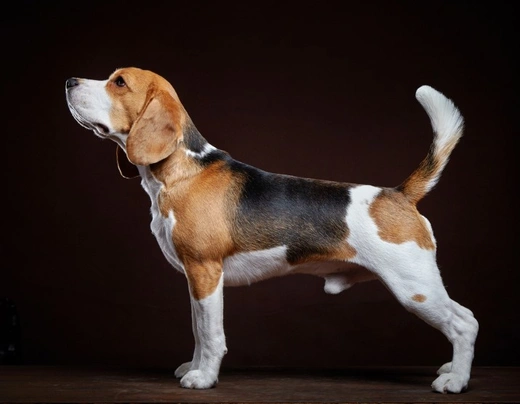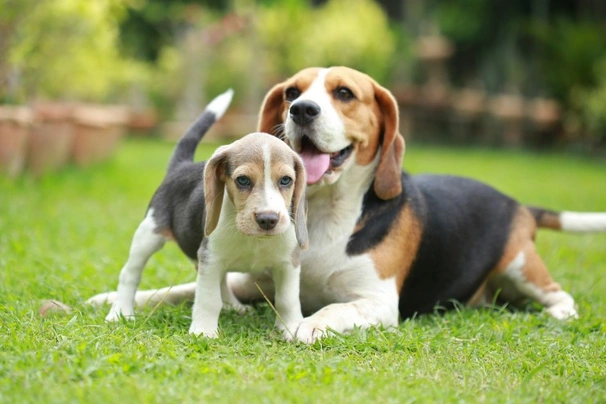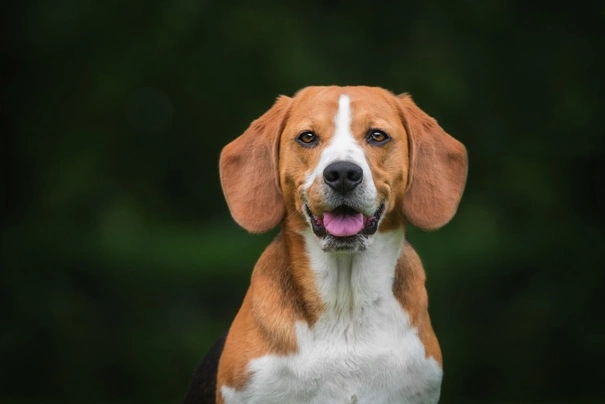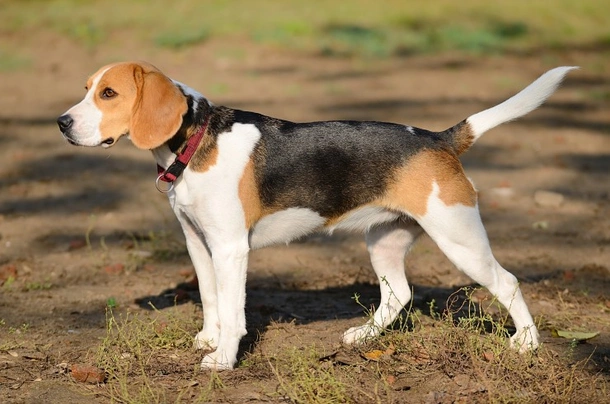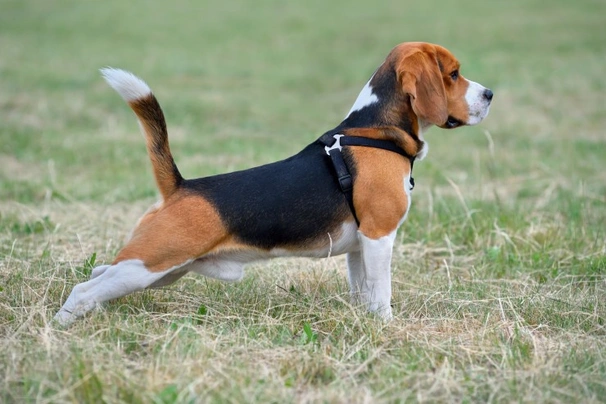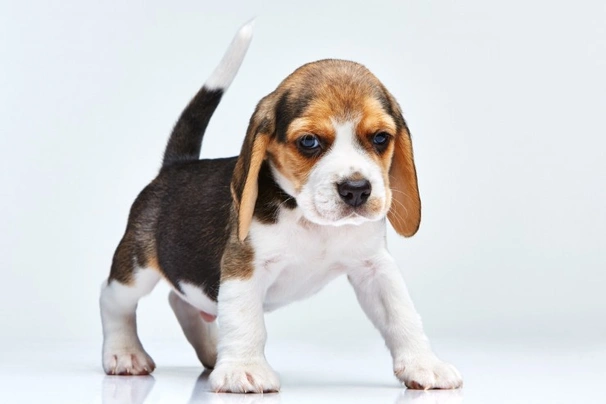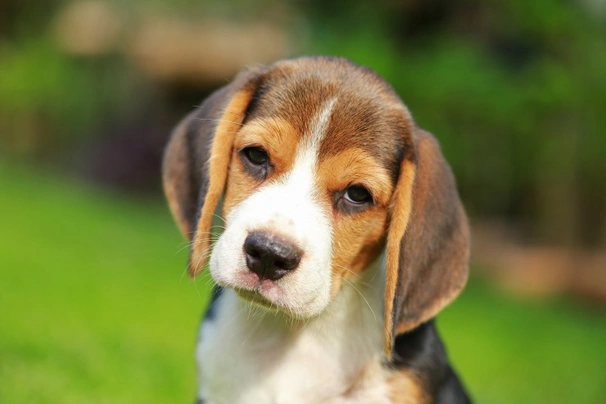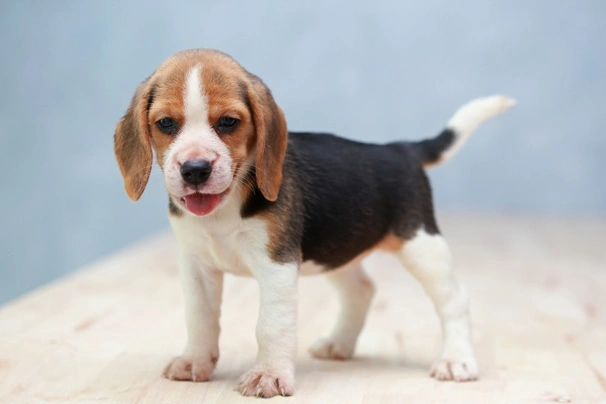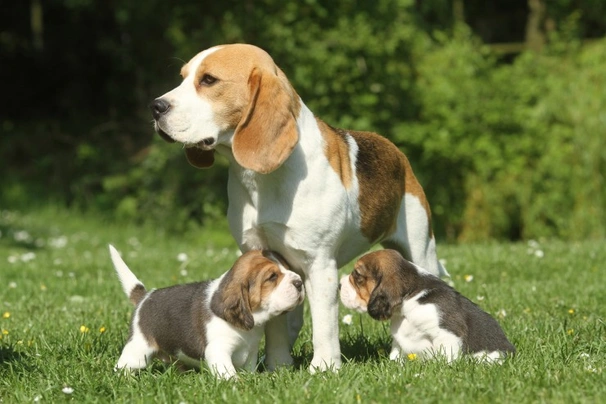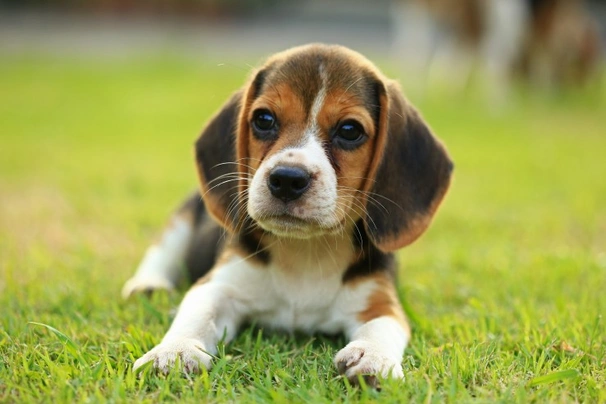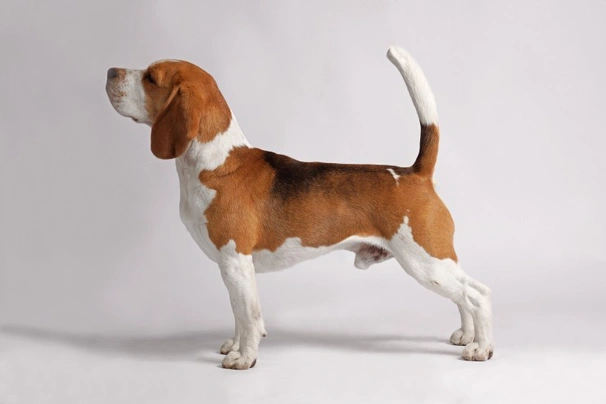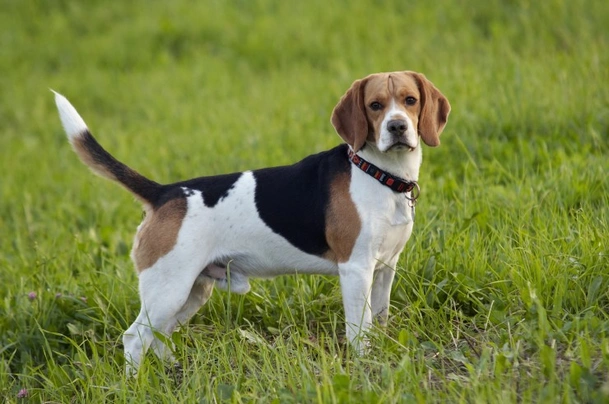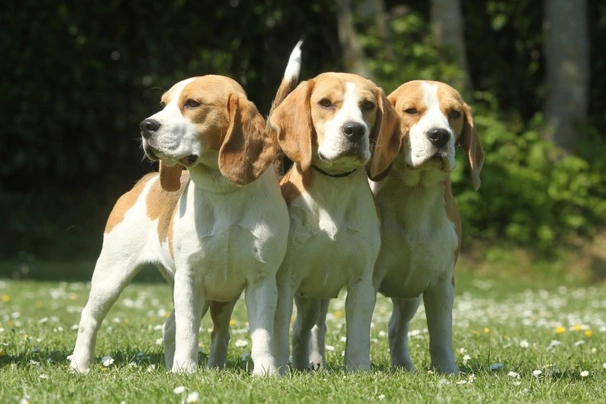Beagle
Pros
Cons
Introduction of the Beagle
Beagles are medium sized dogs that have consistently been a popular choice of family pet and companion dog for decades which is understandable because they have so much going for them. Beagles have also been a firm favourite in the show ring with judges and crowds alike. Although they have retained a strong hunting instinct Beagles are renowned for being relaxed and happy in a home environment and nothing phases these little dogs no matter where they find themselves. There's nothing a Beagles enjoys more than being involved in everything that goes on in a household and they very quickly become valued members of a family.
Beagles boast such kind natures they love life and are a real pleasure to have around thanks to their willingness to please without being overly demanding although they never like to be left on their own for any length of time which potential owners need to bear in mind. As such it would be fair to say that Beagles are best suited to households where at least one person stays at home when everyone else is out so they always have company.
History of the Beagle
The actual origins of the Beagle are a bit of a mystery because the breed is such an ancient one. With this said there are some references to similar type dogs having existed in Ancient Greece that date back to 400 BC whereas in Ancient Britain there are references of similar hunting dogs that date back to 200 AD. It is thought that the Romans during their conquest of Britain brought these dogs with them and they subsequently mated with native British hounds.
Over the next centuries more breeds were introduced to the mix which included Talbot Hounds which William the Conqueror bought over to Britain and which are thought to be the ancestors of the Foxhound too. During the 15th Century Beagles were a firm favourite in the hunting field not only in Britain but in other European countries too which included France Italy and Greece. It is also thought their name "Beagle" may be of Celtic origin and that the Celts used very similar dogs during the Roman invasion.
As such dogs very similar looking to the Beagle have been around for centuries with images of them being seen in paintings and literature dating as far back as the reign of King Henry VIII and Queen Elizabeth I. However the dogs seen in old masterpieces were wirehaired and small enough for them to be carried by huntsman in their pockets. Over the years and through selective breeding larger dogs were bred although smaller versions still existed which came to be known as "Pocket Beagles" with these little dogs still existing even to this day.
Towards the middle of the 18th Century things changed and Beagles started to be replaced by their larger cousins the Foxhound as well as other bigger hounds because more speed was needed to chase down larger prey. Luckily Beagles were still used by farmers and landowners to coarse hares in many southern counties of the land which saw the breed continue to thrive.
It was in the 1830s that Reverend Phillip Honeywood developed a pack of Beagles which are the dogs that formed the foundation stock of the breed we see today although at the time there were two other packs that existed. However it was the pack that Honeywood developed that was reputed to be the best of all three packs and a man called Thomas Johnson refined the breed producing attractive dogs that were skilled hunters. There were in fact two types of Beagle back then one being a smooth coated dog and the other being rough coated which although successful in their day sadly this example of the Beagle does not exist today.
There were 18 packs of Beagles by 1887 which ensured the breed survived and then The Beagle Club was established in 1890 in the UK with a first breed standard being drawn up at the same time. The Association of Masters of Harriers and Beagles was formed the following year which ensured the breed prospered and by 1902 there were 44 packs throughout the UK.
Today the Beagle is among one of the most popular choices of family pets with people both here in the UK and elsewhere in the world all thanks to their lovely looks and kind affectionate loyal natures consistently being at the top of the Kennel Club's list of most sought after dogs in the country whether in the home environment or in the field.
Interesting facts about the breed
- Is the Beagle a vulnerable breed? No they are among one of the most popular dogs in the UK as well as elsewhere in the world
- Beagles are thought to have been around as far back as 500 BC
- The first Beagles were very small dogs
- They have white tips to their tails
- Queen Elizabeth I was particularly fond of the breed
- Snoopy is a Beagle
Appearance of the Beagle
Height at the withers: Males 33 - 41 cm 33 - 41 Females cm
Average Weight: Males 10 - 11 kg Females 9 - 10 kg
Height: Males 33 - 41 cm Females 33 - 41 cm at the withers
Beagles are compact little dogs that always look alert and ready to get involved in anything that is asked of them whether they are in the field or in a home environment. Beagles have quite a large head in relation to size of their body with females having slightly finer heads than their male counterparts. They have shortish muzzles with a broad nose which ideally should be black although a lighter colour is allowed in dogs with lighter coloured coats. Beagles have nice wide nostrils which adds to their overall kindly looks and appeal.
Their eyes can be either hazel or a darker colour and they are set well apart on a dog's head which gives these dogs a lovely kind expression they are so well known for. A Beagle's ears are long and which fall down to the level of their noses when a dog lowers their head. Ears are nicely rounded and soft to the touch. Their mouths are strong looking with a perfect bite.
Beagles have longish necks which allows them to easily follow a scent with their noses firmly planted on the ground. They hold their necks slightly arched which gives these dogs a noble look about them when they are on the move or standing still. Their forequarters are strong with shoulders that are well laid back and their front legs are straight well-muscled and nicely boned.
Beagles as previously mentioned are compact little hounds which means they have sturdy bodies with a nice level topline and well sprung ribs that run far down their body. However it's in their hindquarters that Beagles boast a lot of power with strong thighs and powerful looking back legs. Their feet are well knuckled and firm with strong pads and short nails. Beagles have moderately long tails set high and which dogs carry gaily in the air adding to their happy and fun-loving looks.
When it comes to their coat Beagles have a short tight and extremely waterproof coat which provides them with a tremendous amount of protection against the elements. The accepted colours under the Kennel Club breed standard are as follows:
- Badger Pied
- Badger Pied Mottle
- Black & White
- Black & White Mottle
- Blue White & Tan
- Blue White & Tan Mottle
- Hare Pied
- Hare Pied Mottle
- Lemon & White
- Lemon & White Mottle
- Lemon Pied
- Lemon Pied Mottle
- Red & White
- Red & White Mottle
- Tan & White
- Tan & White Mottle
- Tricolour
- Tricolour Mottle
- White
All colours with the exception of “all white” dogs can be mottled and the tip of a dog's rear end is white which is perfectly acceptable under the KC breed standard.
Gait/movement
When Beagles move they do so with nice level backs with no hint of a roll at all. They cover a lot of ground with long-reaching strides in their front legs without any sort of high action and plenty of drive from their back legs.
Faults
The Kennel Club frowns on any exaggerations or departures from the breed standard and the severity of any faults would be judged on how they affect a Beagle's overall health and wellbeing as well as their ability to perform or work.
Male Beagles should have both testicles fully descended into their scrotums and it is worth noting that a Beagle could be a little taller or shorter and a slightly heavier or lighter than described in their breed standard which is given to be used as a guide only.
Temperament of the Beagle
Beagles are known to be very sociable and often mischievous characters by nature which are just two of the reasons they make such wonderful pets to have around. Once settled into a home they become valued members of a family enjoying nothing more than being involved in everything that goes on in a household.
If you are thinking about sharing your home with a Beagle and you have a garden one of the first things you would need to do is make sure it is ultra-secure because these dogs may be smallish in stature but they are superb escape artists and they will quickly find any weak spots in fencing and garden gates. They are also extremely skilled "diggers" and would soon plough their way under a fence if they find they can.
Beagles boast lovely temperaments and enjoy being around people and other animals too. They hate being left to their own devices and would be seriously unhappy if left alone for even shorter periods of time. With this said they are tough little dogs and although they do tolerate children kids must be taught how to behave around them. Beagles are not the best choice of pets for people with very young families because finding enough time to spend with a dog and toddlers can prove challenging and Beagles need a lot in the way of attention.
Another thing to bear in mind is that Beagles are exceptional at the job they were originally bred to do which was to track down a scent. As such letting a dog off their lead in a park could result in having to track them down once they've gone off after a scent. With this said it's essential for Beagles to be taught the "recall" command from a young age and to reinforce the command throughout a dog's life.
Are they a good choice for first time owners?
Beagles are a great choice for first time dog owners because they are so people-oriented and eager to please but their training and education must begin early and dogs need to know who they can look to for direction and guidance to be truly well-rounded characters.
What about prey drive?
Beagles are highly skilled scent hounds they are renowned for their ability to track a scent down as such it's best to keep a dog on a lead when walking them in places they might pick up something interesting and take off to investigate what's at the other end. With this said because Beagles are so eager to please and intelligent they can be taught the "off" and "leave it" command which they do respond to well providing they are taught these from an early enough age.
What about playfulness?
Beagles are playful and fun-loving characters by nature and quickly learn how to please their owners. They adore being entertained and being the centre of attention which is why they are so highly trainable and a joy to have in the home. They remain very playful right into their senior years too.
What about adaptability?
Beagles are adaptable and given their size will happily live in town in an apartment providing they are given the right amount of daily exercise and mental stimulation to prevent boredom from setting in. With this said like all scent hounds Beagles are never happier than when they have a large back garden to roam around in and they thoroughly enjoy spending time with an owner whose job takes them into the great outdoors the majority of the time.
What about excessive barking?
Providing a Beagle is well socialised and educated from a young age because they are known to like the sound of their own voices which is a trait that needs to be gently curbed when a Beagle is still young and therefore more receptive to being gently moulded into being a quieter dog. With this said a bored Beagle would quickly learn to bark so they can get the attention they crave which could become a problem.
Do Beagles like water?
Some Beagles love swimming and are therefore not afraid of water. However other dogs don't even like to get their feet wet and should never be forced to go into water if they don't want to. With this said care should always be taken when walking a Beagle off the lead anywhere near more dangerous water courses just in case a dog decides to leap in or they accidentally fall in.
Are Beagles good watchdogs?
Beagles are not natural watchdogs because they are too social by nature and enjoy the company of other dogs and people alike even if they don't know them. With this said some Beagles are quick to let their owners know when there are strangers about or when there is something they don't like going on in their environment.
Intelligence / Trainability of the Beagle
Beagles are known to be intelligent however it's essential for their training and education to start as early as possible or these dogs can become wilful and unruly. On the upside Beagles are generally eager and willing to please and providing they are given the right sort of guidance and direction from an early age they grow up to be well-rounded obedient dogs it just takes a little more time and patience with them.
Beagles need to be handled firmly but always fairly and their training needs to be consistent throughout their lives. Any unwanted behaviours should be nipped in the bud gently yet firmly and this includes their tendency to bark. Beagle puppies as previously mentioned need to be taught not to bark excessively and this must be done early before it turns into a real issue further down the line. A Beagle's education must begin as soon as a puppy arrives in their new homes and they need to be taught the following commands from the word go:
- Come
- Sit
- Stay
- Quiet
- Leave it
- Down
- Bed
Once a dog is older they can be taught other more complicated commands to ensure they grow up to be more obedient and well-behaved adult dogs.
Children and other
As long as a Beagle is well socialised from a young age and introduced to as many new situations and children as possible they are generally good around them although not many dogs like it when the kids are too noisy or boisterous around them which is why children need to be taught how to behave around a dog and any interaction needs to be well supervised by an adult at all times to make sure things stay calm. Children also need to be taught not to go near their pet when they are eating or asleep because these are the times that dogs need to be left alone.
When it comes to other pets and animals which includes cats providing a Beagle has been introduced to them from a young age they are generally very good around them. Beagles generally get on well with other animals they have grown up with too.
Health of the Beagle
The average life expectancy of a Beagle is between 12 to 15 years when properly cared for and fed an appropriate good quality diet to suit their ages.
However as with a lot of other pure breeds the Beagle is known to suffer from a few hereditary and acquired health issues which are worth knowing about if you want to share your home with one of these fun-loving and lively dogs. Health issues the breed is prone to suffer from includes the following:
- Steroid Responsive Meningitis (SRM) often referred to as Beagle Pain Syndrome or Stiff Beagle Disease
- Hip Dysplasia
- Canine Epilepsy
- Musladin-Leuke Syndrome (MLS) - Chinese Beagle Syndrome - DNA test available
- NCCD - DNA test available
- Factor VII & IGS - DNA Test Available
- Cherry Eye
- Beagle Tail - also referred to as Limber Tail or Limp Tail
- Catalase Deficiency- DNA Test Available
Because Beagles have long ears they are also prone to suffer from infections simply because air cannot circulate around their inner ears and as such moisture can build up creating the perfect environment for a yeast infection to take hold. The other thing to bear in mind is that Beagles have a tendency to put on too much weight if they are not given enough exercise or fed an incorrect diet. Carrying too much weight can seriously impact a dog's overall health which can reduce their life span quite considerably.
Another condition that Beagles seem to suffer from is called "reverse sneezing" which sounds as if a dog is chocking. Not much is known as to why some dogs do this but the good news is that it is not dangerous or harmful to dogs when they do. In short it sounds worse than it actually is.
What about vaccinations?
Beagle Puppies would have had their first vaccinations but it's essential for them to have their follow-up jabs at the right time with the vaccination schedule being as follows:
- 10 -12 weeks old bearing in mind that a puppy would not have full protection straight away but would be fully protected 2 weeks after they have had their second vaccination
There has been a lot of discussion about the need for dogs to have boosters. As such it's best to talk to a vet before making a final decision on whether a dog should continue to have annual vaccinations which are known as boosters.
What about spaying and neutering?
A male Beagle can safely be neutered when they are 6 months old and females can be spayed when they are 6 months old too.
What about obesity problems?
Beagles are prone to putting on weight if they are not given the correct level of daily exercise to suit their calorie intake which is why it's essential to keep an eye on a dog's waistline and to adjust the amount of food and exercise they are given accordingly. Obesity puts a lot of strain on a Beagle's body and their internal organs which could result in shortening a dog's life by several years.
What about allergies?
Some Beagles can develop allergies as well as intolerances to certain foods. With this said there are several things that can trigger an allergy and this includes the following:
- Environment
- A reaction to certain chemicals commonly found in household cleaning products
- Seasonal allergies which includes pollen and grasses
- Food which includes certain meats and cereals often used as ingredients in commercially produced dog food
- Tick and flea bites
- Dust mites
- Mould
Participating in health schemes
There are several health schemes available for the Beagle which includes the following and all breeders are advised by the Kennel Club to have their stud dogs tested before using them for breeding purposes as this is the only way of ensuring that their offspring are as healthy as possible:
What about breed specific breeding restrictions?
Currently there are no breed specific restriction set in place for the Beagle by the Kennel Club.
What about Assured Breeder Requirements?
Under the Kennel Club regulations it is mandatory for all Assured Breeders to have stud dogs tested using the following schemes to ensure good breeding practices and the KC strongly recommends that other breeders do the same:
The Kennel Club strongly advises that all breeders have dogs tested using the following scheme:
Caring for the Beagle
As with any other breed Beagles need to be groomed on a regular basis to make sure their coats and skin are kept in top condition. They also need to be given regular daily exercise to ensure they remain fit and healthy. On top of this Beagles need to be fed a good quality well balanced diet that meets all their nutritional needs throughout their lives for them to remain fit and healthy.
Caring for aBeagle puppy
Beagle puppies are incredibly cute so it's very easy to let them get away with things which can have disastrous results in the long-term. It's far better to lay down ground rules boundaries and limits as soon as puppy arrives in their new homes so they understand what is expected of them. It's also essential for homes and gardens to be puppy-proofed well in advance so there's less chance of a puppy getting into trouble or injuring themselves. This includes making secure any electric wires and cables bearing in mind that puppies like to chew on things.
Garden tools and implements must be put away too because puppies will play boisterously when they are outside and could well injure themselves in the process if they knock into any of the more dangerous tools commonly found in a back garden.
It's also important to set up a nice quiet area a puppy can retreat to when they want to take a nap and it's worth noting that they can sleep up to 21 hours a day which they need to do to grow and develop as they should. The quiet area should not be too out of the way because puppy needs to know someone is around and owners need to be able to hear their pets just in case they get into trouble and need rescuing.
A puppy would have been wormed before being sold and the documentation a breeder provides for a puppy must have all the details of their worming date and the product used as well as the information relating to their microchip. It is essential for puppies to be wormed again keeping to a schedule which is as follows:
- Puppies should be wormed at 6 months old
- They need to be wormed again when they are 8 months old
- Puppies should be wormed when they are 10 months old
- They need to be wormed when they are 12 months old
Things you'll need for your puppy
There are items needed to care for a puppy which should be purchased well in advance of their arrival. The items needed include the following:
- Feed and water bowls making sure they are not too deep and ideally they should be ceramic rather than plastic or metal
- A good quality dog collar harness and lead
- A dog crate that's not too small or too big that a puppy would feel lost in it
- A well-made dog bed bearing in mind that a puppy could well chew on it
- Baby and/or dog blankets to use in the puppy's crate and dog bed
- Dog specific toothpaste and tooth brush
- Shampoo and conditioner specifically formulated for use on dogs
- Grooming equipment
Keeping the noise down
All puppies are very sensitive to loud noises so it is important to keep the volume of a television down and not to play music too loudly either because it could frighten a Beagle puppy and prevent them from napping as they should during the day.
Keeping vet appointments
Puppies are always vaccinated before they are sold but as previously mentioned it is up to their new owners to make sure they are given their follow-up shots at the right time which should be as follows:
- 10 -12 weeks old bearing in mind that a puppy would not have full protection straight away but would only be fully protected 2 weeks after they have had their second vaccination
When it comes to boosters it's best to discuss these with a vet because there is a lot of debate about whether a dog really needs them after a certain time. However if a dog ever needed to go into kennels their vaccinations would need to be
What about Beagles when they reach their golden years?
When Beagles reach their golden years they do slow down in many ways and they might start showing their age with more grey hairs appearing on their faces and more especially around their muzzles. Apart from a change in their appearance a Beagle's personality might change too and this includes on how quick they are to respond to a command or when their names are called. The reason for this is that many older dog's hearing is not as good as it once was. Other changes to watch out for in a Beagle when they reach their senior years include the following:
- Their vision might be impaired and their eyes seem cloudy
- Older dogs tend to sleep more during the day and they get up more frequently at night which is often because their cognitive function is not as sharp as it was when they were young which means older dogs are more easily confused
- They tend to be less tolerant of loud noises and sounds
- Older dogs often suffer from arthritis so it's important to invest in a comfy dog bed and ideally one that a Beagle finds easier to get out of
- Dogs when they are older can be a little fussier about their food so it's important to rethink their diet and to make sure they are getting all the nutrients they need to stay healthy
- An older dog's immune system often does not offer them the same protection against illness and infection which puts them more at risk of catching something and why they should see the vet more routinely
- An older Beagle might not be so keen to go out for a walk and more especially longer ones
- They muscle tone and body condition is not as good as when they were young
Grooming of the Beagle
Beagles are easy maintenance in the grooming department all thanks to their short neat coats. When they do get dirty or muddy it's easy to give them a quick wipe over with warm water and a sponge. A daily brush is all that a Beagle needs to keep their coats and skin in good condition and to keep any shed hair under the control. As with other breeds the Beagle shed more in the Spring and then again in the Autumn when a dog might need more frequent brushing than at other times of the year.
If you decide to get a Beagle puppy it's important to start grooming them as early as possible so they get used to all the tools needed to keep their coats in good condition. It's also essential to teach puppies that having their nails touched is not scary and that a grooming session is a nice experience so they look forward to the one-to-one attention they are given.
As previously mentioned it's important to keep a close eye on a Beagle's ears to make sure they are dry and no infection is flaring up which can be notoriously difficult to clear up.
Grooming tools needed for a Beagle
Having the right grooming tools helps keep a Beagle's coat and skin in top condition. Even though they are low maintenance on the grooming front Beagles enjoy being brushed and appreciate the one to one contact they are given when they are being groomed. The tools needed to keep a dog's coat looking good are as follows:
- A grooming glove
- A slicker brush
- A bristle brush
- A fine toothed comb
- Nail clippers
- A pair of round ended scissors
- Dog specific shampoo and conditioner
Exercise of the Beagle
Beagles need a lot in the way of exercise and they also need to be given a lot of mental stimulation to the truly happy well balanced dogs. This means a good 60+ minutes a day and ideally dogs need to be walked twice a day. They also benefit from being allowed to roam around a secure garden as much as possible but the fencing needs to be "Beagle proof" because they are known to be skilled escape artists when the mood takes them.
Beagle puppies only need to be given a little exercise to begin with because their joints and bones are still developing. As such a little playtime in a garden is ideal until they have had all their vaccinations. Then it's important for them to be introduced to as many other animals pets and situations as possible so they grow up to be confident adult dogs.
Feeding of the Beagle
If you get a Beagle puppy from a breeder they would give you a feeding schedule for your new pet and it's important to stick to the same routine feeding the same type of food to a puppy to avoid any tummy upsets. You can change a puppy's diet but this needs to be done very gradually always making sure they don't develop any digestive upset and if they do it's best to put them back on their original diet and to discuss things with the vet before attempting to change their food again.
A mature Beagle needs to be fed a good quality well-balanced diet that meets all their nutritional needs throughout their lives. It's also important to keep a close eye on their weight because as previously mentioned Beagles are prone to put on weight which means limiting the amount of rewards they are given even during their training.
Feeding guide for a Beagle puppy
Once a puppy is settled into their new homes it is safe to change their diets but as previously touched upon it needs to be done gradually and carefully to avoid any tummy upsets. As a rough guide Beagle puppies can be fed the following amounts every day to ensure they are getting all the nutrients they need to grow and develop properly:
- 2 months old - 150 g to 208 g depending on a puppy's build
- 3 months old - 176 g to 246 g depending on a puppy's build
- 4 months old - 187 g to 264 g depending on a puppy's build
- 6 months old - 189 g to 270 g depending on a puppy's build
- 7 months old - 171 g to 250 g depending on a puppy's build
- 8 months old - 153 g to 233 g depending on a puppy's build
- 10 months old - 136 g to 194 g depending on a puppy's build
- 11 months old - 134 g to 192 g depending on a puppy's build
Once a puppy is 12 months old they can be fed adult dog food as shown below.
Feeding guide for an adult Beagle
As a rough guide an adult fully grown Beagle can be fed the following amounts every day to ensure they stay fit and healthy:
- Dogs weighing 9kg can be fed 171g to 225g depending on activity
- Dogs weighing 10kg can be fed 192g to 252g depending on activity
- Dogs weighing 11kg can be fed 212g to 279g depending on activity
- Dogs weighing 12kg can be fed 232g to 305g depending on activity
Beagle price
If you are looking to buy a Beagle you would need to pay anything from £250 to over £900 for a well-bred pedigree puppy. The cost of insuring a male 3-year-old Beagle in northern England would be £19.99 a month for basic cover but for a lifetime policy this would set you back £49.59 a month (quote as of August 2017). When insurance companies calculate pet insurance they factor in a few things and this includes where you live in the UK and a dog's age and breed.
When it comes to food costs you need to buy the best quality food whether wet or dry to feed your dog throughout their lives making sure it suits the different stages of their lives. This would set you back between £30 - £40 a month. On top of this you would need to factor in veterinary costs if you want to share your home with a Beagle which includes their initial vaccinations their boosters the cost of neutering or spaying your dog when the time is right and then their annual health check visits all of which could quickly add up to well over a £800 a year.
As a rough guide the average cost to keep and care for a Beagle would be between £70 to £100 a month depending on the level of insurance cover you opt to buy for your dog but this does not include the initial cost of buying a well-bred pedigree Beagle puppy.
Buying advice
When visiting and buying any puppy or dog there are many important things to consider and questions to ask of the breeder/seller. You can read our generic puppy/dog advice here which includes making sure you see the puppy with its mother and to verify that the dog has been wormed and microchipped.
Beagle are an extremely popular breed both in the UK and elsewhere in the world which means that well-bred puppies command a lot of money. As such with Beagle there is specific advice questions and protocols to follow when buying a puppy which are as follows:
- Beware of online scams and how to avoid them. You may see online and other adverts by scammers showing images of beautiful Beagle puppies for sale at very low prices. However the sellers ask buyers for money up front before agreeing to deliver a puppy to a new home. Potential buyers should never buy a Beagle puppy unseen and should never pay a deposit or any other money online to a seller. You should always visit the pet at the sellers home to confirm they are genuine and make a note of their address.
- As previously touched upon Beagle are among the most popular breeds in the UK. As such there are many amateur breeders/people who breed from a Beagle far too often so they can make a quick profit without caring for the welfare of the puppies their dam or the breed in general. Under Kennel Club rules a dam can only produce 4 litters and she must be between a certain age to do so. Anyone wishing to buy a Beagle puppy should think very carefully about who they purchase their puppy from and should always ask to see the relevant paperwork pertaining to a puppy's lineage their vaccinations and their microchipping

Beautiful Beagle puppies Rare blue tri& tri colour
£1,000
Davicard/duffosee beagles
£1,295
